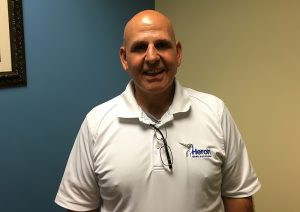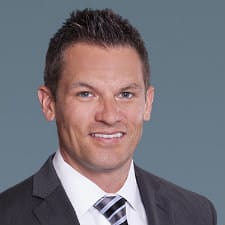How Does Outpatient Rotator Cuff Surgery Get Patients Back to Work?
- What Are the Benefits of Outpatient Rotator Cuff Surgery?
- What is a Rotator Cuff Tear?
- How Does the Rotator Cuff Get Damaged?
- What Are Treatment Options for a Rotator Cuff?
- What Are the Results and Recovery Process for Rotator Cuff Surgery?
Ronald Colletti isn’t one to sit around. When the pain in his shoulder started preventing him from doing ordinary, everyday activities, he knew he had to take action.
“It’s amazing, the simple little things that we all take for granted, like brushing your teeth or working on the computer, were taken away from me for a while,” says Ronald. “And you want to get back to work and get functional again.”
Ronald turned to Bradd G. Burkhart, M.D., a board certified orthopaedic surgeon specializing in sports medicine, knee and shoulder surgery at Orlando Orthopaedic Center, for evaluation and treatment. Together, they determined outpatient rotator cuff surgery was the best treatment option to get Ronald back on the job and enjoying the little things in life he cherishes.
“I actually had two surgeries; the right shoulder in 2013 and the left one two months ago,” says Ronald. “Pretty much I got almost full range of motion (back). I had a lot of help from the whole rehab team; just by doing the exercises and working hard, getting my arm over my head again.”
According to the American Academy of Orthopaedic Surgeons, every year about 200,000 Americans require shoulder surgery to repair their rotator cuff, and another 400,000 Americans undergo surgery for related rotator cuff tendonitis or for partial tears.
Although not every patient will meet all requirements to have an outpatient rotator cuff surgery, those who do usually decide to undergo this minimally-invasive procedure.
What Are the Benefits of Outpatient Rotator Cuff Surgery?
“Surgeries performed in the outpatient setting are typically found to be safer, more convenient and less stressful for patients and their families,” says Dr. Burkhart.
Other benefits of outpatient rotator cuff surgery include:
- Patients return home the same day as surgery, compared to several days in the hospital with an inpatient procedure
- Easier access when checking-in and checking-out at an outpatient center when compared to a typical hospital
- Decreased risk of infection
- Recovery starts at home, often leading to increased comfort and a reduced period of time required to fully heal
“My wife and I came to the center, the team greeted me, they told me what I was going to be up against,” says Ronald. “(The surgery lasted) 45 minutes. (Then) you’re out, you’re done. It’s amazing.”
Americans in general are living longer, healthier and more active lifestyles than ever before. As individuals get older, their risk of musculoskeletal problems, including rotator cuff injuries, increases. Some studies have shown that rotator cuff tears may be as high as fifty percent in people aged sixty-five and older.
What is a Rotator Cuff Tear?
A rotator cuff is a group of muscles and tendons that surrounds the shoulder joint. These tendons and muscles connect the upper arm to the shoulder blade and provide stability while helping the shoulder rotate and function.
“A tear to one of these tendons can cause intense pain, a decrease in range of motion and instability in the shoulder,” says Dr. Burkhart. “When the patient has failed all nonsurgical, conservative treatment methods we recommend surgery to provide relief and return to function.”
Dr. Burkhart explains that surgery to repair a torn rotator cuff involves reattaching the torn tendon to the head of the upper arm bone (humerus). Partial tears may only need a debridement or trimming. He says tendons can tear as a result of overuse or injury; and most rotator cuff tears occur as the result of wear and tear, putting people at age 40 at a greater risk.
How Does the Rotator Cuff Get Damaged?
The tendons of the rotator cuff can get torn, resulting in significant pain and loss of arm mobility. Injury and degeneration over time are the two primary reasons for rotator cuff tears.
The natural wear and tear of the shoulder joint over the long term, especially in the dominant arm, can lead to a degenerative rotator cuff tear. Other factors leading to common rotator cuff injuries include:
- Repetitive stress: sports with repetitive motions such as tennis, baseball or weight lifting can increase the chances of a tear. Manual jobs such as painting, carpentry and other overhead chores can put additional stress on the shoulder joint and lead to overuse tears.
- Reduced blood supply: tendons need an ample supply of blood in order to replenish and to heal. In older individuals, the rotator cuff tendons receive less and less blood, which can result in tears.
- Trauma: traumatic events/injury can also cause tears in the rotator cuff. Lifting a grandchild, placing the luggage in an overhead compartment, falls, and lifting heavy objects are just some of the ways to tear the rotator cuff.
Typical symptoms of a torn rotator cuff include:
- Pain while resting at night, coupled with increased discomfort when lying on the concerned shoulder
- Experiencing pain when raising or lowering the arm
- A feeling of weakness in the arm when raising or rotating it
- Cracking sounds or sensations when the shoulder is moved in certain ways
What Are Treatment Options for a Rotator Cuff?
Both surgical and non-surgical alternatives exists for treating a torn rotator cuff.

Ronald says his rotator cuff surgery with Dr. Burkhart helped him get back to work and his favorite activities.
Non-surgical options include:
- Resting the damaged shoulder and/or using a sling to immobilize it
- Stopping the activities that generate the shoulder pain
- Over the counter anti-inflammatory medicine such as aspirin and ibuprofen
- Physical therapy and exercises to strengthen the shoulder. Stretching and solidifying the muscles around the shoulder joint can reduce pain and limit further injuries
- Steroid or cortisone injections may relieve pain and swelling if other non-surgical methods prove ineffective
What Are the Results and Recovery Process for Rotator Cuff Surgery?
Surgery is the first step on the road to full recovery. Rehabilitation through physical therapy plays a crucial role in restoring the strength and mobility of the shoulder and allowing the patient to get back to their normal routine. It can take anywhere from three to six months after surgery for the shoulder to fully recover.
Ronald credits the rehabilitation staff at Orlando Orthopaedic for his swift post-surgical recovery.
“From Becky and Michelle and the therapy team, the admin team all the way up to the surgical team – Lynn and Dr. Burkhart are fantastic,” says Ronald. “Every time I called the office with a question, within a few hours, I had an answer. The experience has been fantastic. A tough experience made really easy by Orlando Orthopaedic.”



